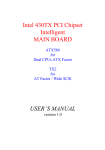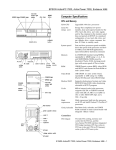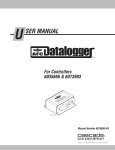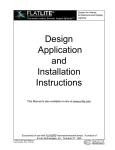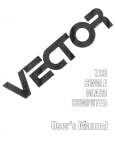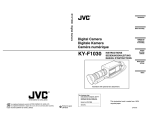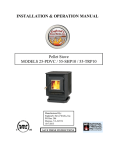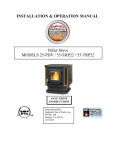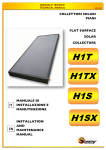Download Western Digital AC2540 Computer Drive User Manual
Transcript
Western Digital Quick Installation (AC2540-AC34000) WD Caviar Series 3.5-Inch EIDE Hard Drives (EZ-Drive 8.0W) DRIVE AC2540 AC2635 AC2700 AC2850 AC21000 AC31000 AC11200 AC21200 AC31200 AC21600 Capacity (MB) DRIVE 540.8 AC31600 639.9 AC22000 730.8 AC32100 853.6 AC32100 1083.8 AC22500 1083.8 AC32500 1281.9 AC33100 1281.9 AC33200 1281.9 AC34000 1624.6 Capacity (MB) 1624.6 2000.3 2111.8 2111.8 2559.8 2559.8 3166.7 3249.3 4000.7 This document is for use with EZ-Drive 8.0 or below. Check the version number on the EZ-Drive diskette. If you have version 9.0W or above, refer to Document 79-850086-000 S0225, 8/97. HARDWARE INSTALLATION Before you begin, gather these supplies: Handling Precautions Western Digital products are designed to withstand normal handling during unpacking and installation. Hard drives are typically damaged because of electrostatic discharge (ESD), rough handling, or shock and vibration. Be aware of the following precautions when unpacking and installing your Western Digital hard drive. Computer system manual DOS and other operating system installation disks or Windows 95 startup disk Operating system manual Small Phillips screwdriver and flat-blade screwdriver Save your packing materials for the unlikely event that you need to return the hard drive. Shipping your hard drive in anything other than the original packaging materials may void your warranty. To avoid ESD problems, ground yourself by touching the metal chassis of the computer before handling the hard drive. Articles of clothing generate static electricity. Do not allow clothing to come in direct contact with the hard drive or circuit board components. Handle the hard drive by the sides only. Avoid touching the circuit board components. Do not drop the hard drive. We recommend that you do not unpack the hard drive until you are ready to install it. Once your Western Digital hard drive is unpacked, place the drive on its antistatic bag on a clean, level work area. Do not stack hard drives or stand the Western Digital hard drive on its edge. Do not remove the tape seal or any labels from the drive; the warranty will be void. Create a Bootable DOS Disk For Windows 3.1x and DOS users, you must have a bootable DOS disk to install your new hard drive. Disk 1 of your standard DOS installation disks is a bootable disk. If you don’t have DOS installation disks, you can create a bootable disk if you have a bootable C: drive. 1. Insert a blank disk into drive A. 2. Type format a:/s and press ENTER. Create a Windows 95 Startup Disk For Windows 95 users, you must have a bootable operating disk before you install the new hard drive. If you don’t have a Windows 95 Startup disk, you can create one if you have a bootable C: drive. 1. Insert a blank disk into drive A. 2. From Windows 95, click My Computer, and then click Control Panel. 3. Click Add/Remove Programs. 4. Select the Startup Disk tab. 5. Click Create Disk. Follow the onscreen prompts to create a Windows 95 startup disk. Open Your Computer 1. Turn off your system. 2. Discharge static electricity by touching the metal chassis of the computer. 3. Unplug your computer. 4. Remove the computer’s outside cover. Consult your computer system manual for details. Be sure to keep all screws and other parts together for reassembly. Back Up Existing Drives Back up the data on your existing hard drive before installing your new Western Digital hard drive. Save the data to floppy disks, tape or other media. Most DOS versions include a backup utility. Consult your operating system or utilities documentation for backup procedures. 79-850078-001 S0210 9-97 Remove Existing Hard Drives If replacing an existing drive, follow these instructions. 1. Disconnect the power cable and interface cable. 2. Remove screws and slide the hard drive out of the drive bay. Handle the drive with care. You might need this drive if you have difficulty installing the new drive. Note: Do not scratch the sides of the hard drive; this will void your warranty. 1 Figure 1. Jumper Settings for Western Digital Hard Drives and which is the slave (D:). We recommend using the new Western Digital hard drive as the master. Set the Drive Jumpers Western Digital is currently shipping hard drives with two types of connectors. Your hard drive may have either a 6-pin or a 10-pin connector. The first 6 pins on each of the jumper blocks are identical. The additional four pins on the 10-pin connector are reserved for future enhancements. If installing the Western Digital hard drive with a non-Western Digital hard drive, obtain jumper configuration information from your original drive manufacturer. Refer to the Troubleshooting section for the phone numbers of non-Western Digital hard drive manufacturers. The Western Digital hard drive is factory set for single drive installation with a jumper in the neutral storage position (across pins 5-3). For standard jumper settings, see Figure 1 on page 2. To designate the Western Digital hard drive as the master drive in a two-drive system, place the jumper on pins 5-6. To designate the Western Digital hard drive as the slave drive in a two-drive system, place the jumper on pins 3-4. Single Hard Drive Installation If installing the Western Digital hard drive as the only hard drive in your system, leave the jumper in the neutral storage position for possible future use. Jumpers are not required for single hard drive installations. To Install a Jumper Carefully place the shunt over the two pins specified in Figure 1. Push the shunt into place until it is firmly seated against the base of the jumper block. Dual Hard Drive Installation If installing the Western Digital hard drive with an existing drive, you must use a jumper to designate which drive is the master (C:), 79-850078-001 S0210 9-97 Note: The master/slave setting is determined by the jumper configuration, not by the order of the drive on the IDE cable. 2 Install Your New Hard Drive 1. Thread the cable through the empty drive bay and slide in the Western Digital hard drive. 2. Attach the end of the 40-pin interface cable to the 40-pin connector on the back of the Western Digital hard drive. Match pin socket 1 on the IDE cable (indicated by a color stripe on the cable) to pin 1 on the Western Digital hard drive. See Figure 3. 3. Attach the computer system power supply cable to the 4-pin power connector on the back of the Western Digital hard drive. The 4-pin connector is keyed to ensure proper insertion. Mounting Hardware Inspect the bay to see whether it is a 3.5-inch or 5.25-inch bay. The Western Digital hard drive fits into a 3.5-inch bay. If installing the Western Digital hard drive in a 5.25-inch bay, you must install the 5.25-inch mounting hardware that is provided. You might also need to install the system manufacturer’s drive rails. Consult your operating system manual for installation into a 3.5-inch bay. Installing the 5.25 Mounting Hardware This step is not required for hard drive installations into a 3.5-inch drive bay. 1. Gently place the hard drive horizontally (circuit board side down) on top of the ESD bag placed on a flat, padded surface. 2. Attach the mounting brackets to the hard drive using the screws provided. For proper grounding, be sure to use ALL FOUR screws. Figure 3. Attaching IDE Cable to the Hard Drive 4. Single Installations: Attach the end of the 40-pin IDE cable from the Western Digital hard drive to the IDE connector on the motherboard or controller card. Match pin socket 1 on the IDE cable (indicated by a color stripe on the cable) to pin 1 on the motherboard or controller card. Dual Installations: Connect the two hard drives by using a three-connector IDE interface cable. A three-connector IDE interface cable is included in this package. Match the orientation of pin socket 1 on the 40-pin three- connector IDE cable to pin 1 on the drive connector. See Figure 3. Figure 2. 5.25-inch Mounting Hardware Drive Rails (Optional) Some computer systems have 5.25-inch drive bays that require unique sliding drive rails to complete the hard drive installation. Because each system manufacturer has a different type of drive rail, rails are not included with Western Digital hard drives. If your system requires drive rails, contact the computer system manufacturer. The following list provides phone numbers for common system manufacturers. Tips: Install single drives at the end of the 40-pin IDE cable. The 40-pin IDE cable should be no longer than 18 inches. The master/slave is determined by jumper configuration, not by the order of the drive on the cable. System Manufacturers: AST Compaq Dell Digital Gateway 2000 HP IBM NEC Packard Bell 79-850078-001 S0210 9-97 817-232-9824 713-518-2000 512-338-4400 603-884-5111 605-232-2000 208-323-2551 800-IBM4YOU 415-528-6000 801-579-0161 5. Mount the Western Digital hard drive in the drive bay using the four mounting screws provided. For proper grounding, be sure to use ALL FOUR screws. If an extra power connector is not available, purchase a Y-adapter from your computer dealer. 6. Check all cable connections. Replace the system cover, but don’t screw it on yet. If you can’t get the new drive to work, you may need to check the connections. 7. Plug in your computer. See the Software Installation section for hard drive setup instructions. 3 DRIVE AC2540 AC2635 AC2700 AC2850 AC21000 AC31000 AC11200 AC21200 AC31200 AC21600 Capacity (MB) CMOS (MB) CHKDSK (MB) DRIVE 540.8 515 540.8 AC31600 639.9 610 639.9 AC22000 730.8 696 730.8 AC22100 853.6 814 853.6 AC32100 1083.8 1033 1083.8 AC22500 1083.8 1033 1083.8 AC32500 1281.9 1222 1281.9 AC33100 1281.9 1222 1281.9 AC33200 1281.9 1222 1281.9 AC34000 1624.6 1549 1624.6 Capacity (MB) CMOS (MB) 1624.6 1549 2000.3 1907 2111.8 2035 2111.8 2035 2559.8 2441 2559.8 2441 3166.7 3020 3249.3 3098 4000.7 3815 CHKDSK (MB) 1624.6 2000.3 2111.8 2111.8 2559.8 2559.8 3166.7 3249.3 4000.7 Table 1. CMOS and CHKDSK Megabytes SOFTWARE INSTALLATION Before using the new hard drive, you need to configure your system BIOS (CMOS Setup program) and partition and format the hard drive. Partitioning and Formatting Your Western Digital hard drive has been low-level formatted at the factory. The hard drive is ready to set up and is defect-free. You must partition and high-level format the hard drive so it can accept files. There are two ways to format and partition the hard drive. CMOS Setup The computer system provides an initial setup utility (CMOS Setup) that allows you to tell the system what type of hardware you are using. You access CMOS Setup with a series of keystrokes or run it from a disk or CD-ROM. CMOS setup procedures vary from system to system. Follow the setup instructions in your computer system manual. 1. Use the EZ-Drive software that you received with the hard drive. 2. Use the DOS utilities FDISK and FORMAT. We recommend using EZ-Drive. It is a safe, fast, and an easy way to partition and format the hard drive. See the section Using EZ-Drive Software for instructions. For instructions on using FDISK and FORMAT, see your DOS user manual. To configure your system for LBA mode: 1. Enter your CMOS Setup program (sometimes called the Setup program). Refer to your system manual for instructions. Important: If you are installing the 2.5 GB or larger drive and are not able to access your CMOS Setup, refer to the 2.5 GB or Larger Hard Drives section on page 5. 2. Select an auto config drive type. The full capacity of your drive should display. See Table 1 for the full capacity of your drive in CMOS. Note: DOS has a 2.1 GB partition limit. If you have a 2.5 GB or larger hard drive, you must create at least two partitions to access the full capacity. EZ-Drive 8.x Software Overview EZ-Drive 8.x software is included with the Western Digital hard drive to help you: Partition and format your new hard drive. Overcome the 528 MB barrier. Overcome the 2.1 GB barrier. Tips: If your CMOS setup does not have an auto config drive type, try selecting Type 01. Then install EZ-Drive. If your system does not have auto config or Type 01 drive types, try user defined and enter 1023x16x63 for the drive parameters. Then install EZ-Drive. If you did not receive the EZ-Drive software, you can download it from our web site at www.wdc.com. Partition and Format: If your system supports the full capacity of the hard drive, EZ-Drive will only partition and format the hard drive. It does not install code on your boot sector. Note: Western Digital defines a decimal megabyte as 1,000,000 (106) bytes. CMOS defines a binary megabyte as 1,048,576 (220) bytes. This is why different utilities report different hard drive capacities. 3. Enable options such as LBA or Translation Mode. If you don’t have either options, you need to upgrade the BIOS or install EZ-Drive. See Troubleshooting for a list of BIOS sources and phone numbers. 528 MB Barrier: Most computer systems built before August 1994 do not support hard drives larger than 528 MB, unless the BIOS is updated or third-party software such as EZ-Drive is installed. 2.1 GB Barrier: Some computer systems built before early 1996 do not support hard drives with more than 4095 cylinders (hard drives larger than 2.1 GB), unless the BIOS is updated or third-party software such as EZ-Drive is installed. EZ-Drive Help Files: To access EZ-Drive help files on the installation disk, select Installation Help from the EZ-Drive main menu. 79-850078-001 S0210 9-97 4 Compatibility: You can use EZ-Drive software with DOS 5.0 and above, Windows 3.1x, Windows for Workgroups, Windows 95, Windows NT, OS/2 2.1x, and OS/2 Warp. 6. After EZ-Drive detects the drive, the following message displays if your system does not support the full capacity of your hard drive. EZ-Drive must control this drive to access the full capacity Press Y to continue installation. 7. EZ-Drive formats the drive now. Follow the instructions onscreen, and when prompted, insert a DOS disk. 8. EZ-Drive has successfully set up your hard drive. Remove any disk from the floppy drive and press ESC to exit and restart the system. Your hard drive is now partitioned and formatted. You cannot use EZ-Drive with Novell NetWare or Unix. Data Compression Software: EZ-Drive is compatible with Stacker, Drivespace, and Doublespace disk compression utilities. Other data compression software may not be compatible. Always back up your data before using any data compression software. Hard Disk Device Drivers: Products that use their own hard disk device drivers, such as third-party disk controllers, may not be compatible with EZ-Drive. Installing an Operating System from Disk If you installed EZ-Drive on the hard drive, you must follow the steps below to install DOS 5.0 and above, Windows 3.1x, Windows for Workgroups, Windows 95, Windows NT, OS/2 2.1x, and OS/2 Warp from disk. If you did not install EZ-Drive, or used it only to partition and format your hard drive, see your DOS manual for installation instructions. Memory Managers: EZ-Drive is fully compatible with the standard memory managers that come with DOS and Windows. However, EZ-Drive loads in conventional memory and may not be compatible with some third-party memory managers. Ontrack Disk Manager and EZ-Drive: Ontrack Disk Manager and EZ-Drive cannot co-exist in the same system. If your existing drive has Ontrack Disk Manager installed and multiple partitions, you cannot install EZ-Drive. We recommend using Ontrack Disk Manager to set up the new hard drive. Caution: If you do not install DOS exactly as described below, the DOS setup routine reformats the hard drive to less than the full capacity. If your existing drive has Ontrack Disk Manager installed and only one partition, you can either use EZ-Drive to convert the Ontrack Disk Manager partition or use Ontrack Disk Manager to set up the new drive. During installation, EZ-Drive detects Ontrack Disk Manager and prompts you to convert the partition to an EZ-Drive partition. If you do, EZ-Drive converts the Ontrack Disk Manager partition to an EZ-Drive partition. 1. Remove any disk from the floppy drive. 2. Press CTRL+ALT+DEL to reboot the system. The following message displays if EZ-Drive is installed on your hard drive. EZ-Drive: Initializing. . . EZ-Drive: Hold the CTRL key down for Status Screen or to boot from a floppy. 3. Press and hold down the CTRL key. A status screen displays. 4. Read the screen prompt and type A. 5. Insert the DOS installation disk 1 into drive A. Press ENTER. Follow the prompts to complete installation. Even though EZ-Drive can convert your Ontrack Disk Manager partition to an EZ-Drive partition without data loss, Western Digital recommends that you back up your data before selecting this option. Note: EZ-Drive can convert single Ontrack Disk Manager partitions only. It cannot convert multiple Ontrack Disk Manager Partitions. USING THE DRIVE It is extremely important to regularly back up the data on your hard drive. In the event of data damage or loss, a backup ensures successful recovery. Using EZ-Drive Software Follow these instructions to partition and format your new hard drive. If your system does not support the full capacity of the hard drive, EZ-Drive installs special code in the boot sector of the hard drive to overcome your BIOS limitations. Consult your operating system documentation for backup instructions and procedures. If your system does support the full capacity of your hard drive, EZ-Drive will only partition and format your hard drive. It will not install code on your boot sector. TROUBLESHOOTING 1. After you complete CMOS setup, insert a bootable DOS or Windows 95 startup disk in drive A. 2. Press CTRL+ALT+DEL to reboot your system. 3. Insert the EZ-Drive disk in drive A. At the A: prompt, type ez and press ENTER. 4. The Micro House EZ-Drive license agreement displays. Press ENTER to start the installation. 2.5 GB or Larger Hard Drives If you install a 2.5 GB or larger hard drive and your system locks up on initial boot, read the instructions in this section. The 2.5 GB or larger hard drives have more than 4095 cylinders. With some systems, the BIOS CANNOT properly recognize hard drives that have more than 4095 cylinders. You know if your system BIOS has this limitation after installing the drive. On the initial boot your system may lock up or show a much smaller drive capacity. If your system locks up, follow the instructions below. If your system reports a much smaller drive capacity, follow the instructions outlined in the Software Installation section. CAUTION: Installing EZ-Drive on any drive that contains software and data will result in the erasure of all software and data on that drive. 5. At the EZ-Drive Main Menu, select Fully Automatic Installation. Press ENTER. Follow the instructions onscreen. 79-850078-001 S0210 9-97 If your system does not respond (locks up)after two minutes, follow these steps: 5 Figure 4. Jumper Settings for 2.5 GB or Larger Hard Drives (Used to overcome the BIOS limitations described in this section.) Note: Use these jumper settings only if you encounter the specific BIOS limitation described in this section. When using these jumper settings, you MUST install EZ-Drive. The new settings allow your system to boot so that you can install EZ-Drive to access the full drive capacity. – OR – If you don’t have a user defined drive type, follow step 2 or 3 below to change the parameters reported to the BIOS. In the future, if you move this drive to another system, you must put the jumper back to the standard position. 1. Turn your system power off, check the IDE interface and power supply cables. 2. Check jumper settings. 3. Turn on your system power. 4. Try to enter your CMOS setup, and set the drive type to auto. If your system still doesn’t respond, you may have a system BIOS that doesn’t support drives with more than 4095 cylinders. If this is the case, these solutions are available: 2. Rejumper the drive as shown in Figure 4 on page 6, and install EZ-Drive. If you use the alternate jumper settings, you must install EZ-Drive. Note: These special jumper settings WILL NOT work for OS/2 Warp, Novell NetWare, or Unix. – OR – 3. Upgrade your BIOS. A properly upgraded BIOS will support the drive. Contact your system manufacturer. See page 3 for a list of common system manufacturers and page 7 for BIOS sources and their phone numbers. 1. Use EZ-Drive. If the system locks up before you can enter CMOS, you may need to turn off your system power and disconnect the IDE cable from the system to access your CMOS setup. Enter your CMOS setup. Refer to your system manual for instructions. Select the Hard Disk Type option for the new Western Digital hard drive. Select a user defined drive type and enter: 1023x16x63. Reconnect the IDE cable to the system. 79-850078-001 S0210 9-97 6 UNINSTALLING EZ-DRIVE This option removes EZ-Drive, and returns control of the drive to your system BIOS. Frequently Asked Questions A short list follows with common questions along and solutions. Q: I get the message “HDD Controller Failure” after installing my Western Digital hard drive. Note: Before uninstalling EZ-Drive, make sure that you have properly configured the BIOS to recognize the full drive capacity. A: This common message may appear when you first boot the system after installing the hard drive. Press F1 to continue. If the message continues to display, retrace the steps outlined for CMOS setup, cabling, and jumper configuration. 1. Insert the EZ-Drive disk into drive A. 2. From the A: prompt, type ez and press ENTER. 3. From the EZ-Drive Main Menu, select Other Options. From the Installation Options screen, select Change Installed Features. 4. Select the drive you want to change. 5. From the Change Installed Features screen, select Controlled by EZ-Drive. Press ENTER to toggle the selection to Disabled. 6. From the Change Installed Features screen, select Save Changes. 7. Press ESC to return to the Installation Options screen, and select Uninstall EZ-Drive. 8. A warning message displays. Type Y to remove EZ-Drive. EZ-Drive is now uninstalled and the BIOS controls this drive. Make sure to follow the installation instructions correctly. Then follow the instructions for using EZ-Drive or FDISK and FORMAT to install the operating system. Q: Do I need to run FDISK and FORMAT ? A: Not if you installed EZ-Drive software. Q. What is a megabyte? A: Hard drive suppliers define a decimal megabyte as 1,000,000 bytes (106 ). Alternatively, a binary megabyte is defined as 1,048,576 (220 ). This is why different utilities will display different numbers of megabytes available for the same drive. The values in Table 1 use the following megabyte definitions: Non-Western Digital Drives If installing the new Western Digital hard drive with a non-Western Digital hard drive, you may have to contact the other manufacturer for master/slave jumper configuration information. Capacity Megabytes CMOS (MB) binary megabytes CHKDSK (MB) decimal megabytes Note: Drives on the secondary IDE port conform to the same requirements for master/slave configuration as the primary IDE port. IBM Maxtor Quantum Seagate/Conner Q: Do I have to do anything to my original hard drive when adding yours to it? (800) IBM4YOU (408) 432-1700 (408) 894-4000 (408) 438-8222 A: Yes, one hard drive must be designated as a master, and the other as a slave. We recommend that you designate the new drive as your master. For non-Western Digital hard drives, consult your original hard drive documentation for master/slave jumper settings. See Non-Western Digital Drives on this page. If the original hard drive uses disk compression software, consult the disk compression documentation before adding another drive. General This section lists procedures to help resolve problems that you may encounter when installing the Western Digital hard drive. Refer to your system documentation to be sure that you followed the setup procedures correctly. Make sure that you partitioned and formatted the EIDE drive and any additional drive with the EZ-Drive or other installation software or DOS FDISK and FORMAT utilities. (If you are making this drive bootable, remember to specify the /S parameter.) Refer to your operating system documentation to check these procedures. If using DOS 3.3 and above, be certain to make one partition active during formatting. Check the physical installation of your system to make sure that: Q: What should I check if my system will not start after I turn on the power? A: Ensure that: 1. The IDE controller card, if installed, is properly seated and connected. 2. The connections at both ends of the hard drive cable are secure and correctly oriented. 3. The jumper selections on your hard drive(s) are set correctly for your installation. 4. The drive is connected to the computer power supply via the 4-pin power connector. Q: I used FDISK and FORMAT to set up my new hard drive. Now, I can’t boot DOS from my newly installed hard drive or access the hard drive after I’ve completed the software installation. - Jumper selections on the drive are correct for your installation. - Cables are correctly connected and seated. - Adapter card, if required, is properly seated, connected, and configured. A: Check the system to make sure: - Power is properly connected to your system and the system is plugged in. 79-850078-001 S0210 9-97 1. You entered the correct hard drive parameters during the system setup procedure. 7 2. Some CMOS Setup utilities might have a boot sequence option. If yours does, verify that the boot sequence is A: then C:. Not all CMOS setup utilities have this option. 3. You correctly partitioned (via the operating system FDISK utility) and formatted (via the operating system FORMAT utility) your newly installed hard drive. 4. You made your primary drive bootable (formatted with /S option). 5. During the FDISK procedure you marked your bootable partition active. Q: My drive will not spin up, or it spins down after a few seconds. Q: I am installing a new Western Digital drive onto a second IDE controller card (secondary port). How do I jumper it? A: Refer to the standard jumper options shown in Figure 1. If it’s the only drive on the cable, jumper it as single. If the drive is paired with another IDE device, jumper it as master or slave. Q: Should I partition my hard drive? Caution: Repartitioning an existing drive destroys all the data. If repartitioning an existing drive, be sure to create a backup first. If your hard drive is 2.5 GB or larger, you must create multiple partitions. A: Ensure that: Western Digital does not have a recommendation for the optimal number of partitions. The following information will help you make the decision. 1. Your power connector is secure and working properly. 2. The orientation of pin socket 1 on the 40-pin IDE cable matches pin 1 on the connector. 3. The drive type in your CMOS setup is correct. EZ-Drive and FDISK utilities allow you to divide your drive into multiple partitions that function as separate drives. In DOS, every file that is stored gets at least one allocation unit (cluster), regardless of the file size. The size of the cluster increases with the size of the partition. For example, if you have a 1024 MB partition, the cluster size is 32 KB. This means that even a 62-byte batch file consumes 32 KB of storage space. A typical mix of application and data files can include thousands of files. If each file contains a few kilobytes of wasted space, this can add up to several megabytes of wasted space. Q: I don’t see the full capacity of my hard drive when installing DOS. A: Two issues affect the installation of your hard drive: 1) some systems do not properly recognize hard drives that have more than 4095 cylinders (drives larger than 2.1 GB); 2) most system BIOS dated before 1994 don’t recognize drives greater than 528 MB. To overcome this limitation, either install EZ-Drive or upgrade your system BIOS. The following list provides the phone numbers for common BIOS sources. The only way to reduce the cluster size is to reduce the partition size. The breakdown for DOS 5.0 and above follows: BIOS Sources: Micro Firmware (Phoenix BIOS only) (405) 321-8333 Phoenix (617) 551-4000 Unicore (508) 686-6468 If you installed EZ-Drive and then incorrectly booted to your DOS installation disks, you may have accidentally used DOS to overwrite your EZ-Drive partitions. You need to use FDISK to delete all partitions, and then re-install EZ-Drive. Be sure to follow the instructions outlined in the section Installing an Operating System from Disk on page 5 FDISK Partition Size* Cluster Size 0 - 127 MB 128 - 255 MB 256 - 511 MB 512 - 1023 MB 1024 - 2047 MB 2 KB 4 KB 8 KB 16 KB 32 KB * FDISK reports binary megabytes (1,048,576 bytes), not decimal megabytes (1,000,000 bytes). All numbers above are shown in binary megabytes. Note: The maximum partition that can be created in DOS is 2048 MB. Q: Will my drive work with Windows 95? Q: The reported capacity of my hard drive is MUCH smaller than Table 1 shows it should be. A: Yes. Your drive has been thoroughly tested in the Western Digital FIT Lab and is compatible with Windows 95. A: Your system BIOS improperly handles hard drives that report greater than 1024 cylinders. Use the supplied installation software to get the full capacity of your drive. Q: I have a 2.5 GB or larger drive. Can I create one partition only? A: No. DOS has a 2.1 GB partition limitation. You must have at least two partitions to access the full capacity of your drive. Q: How much memory does EZ-Drive use? A: 5 KB. Q: What will happen if I install EZ-Drive on a hard drive that has Ontrack Disk Manager? Q: How can I get 32-bit disk access in Windows? A: EZ-Drive and Ontrack Disk Manager cannot coexist in the same system. If the existing hard drive has only one partition and Ontrack Disk Manager already installed, EZ-Drive converts the Ontrack Disk Manager partition to an EZ-Drive partition. Back up your hard drive before installing EZ-Drive. If the existing hard drive has multiple partitions and Ontrack Disk Manager installed, EZ-Drive will not install. Use Ontrack Disk Manager to set up the new hard drive. A: Use the 32-bit disk access driver included on the software installation disk. Install the driver by running the EZ-Drive’s SETUP.EXE program, or use the DMCFIG program if you have Ontrack Disk Manager. 79-850078-001 S0210 9-97 8 Q: Can I install Windows NT 3.5x, OS/2 2.1x or OS/2 Warp on my drive that originally was installed with EZ-Drive? ONLINE SERVICES Online services include general product and contact information, installation guides, downloadable drivers, and frequently asked questions. A: Yes, but you must disable floppy boot protection before installing EZ-Drive. See EZ-Drive help files for details. Internet: www.wdc.com Q: I’ve read the entire Troubleshooting section and I still cannot correctly install my drive. FTP Site: ftp.wdc.com A: If none of the solutions in this section solve your problem, there are other options available: 1) Read the README.CAV text file on the EZ-Drive or Ontrack Disk Manager disk for additional troubleshooting information; 2) Check Western Digital online services for a more comprehensive list of frequently asked questions; 3) Contact your dealer; or 4) Have the EZ-Drive disk available and contact Western Digital Technical Support. America Online: Keyword: WDC Western Digital 8105 Irvine Center Drive Irvine, California 92618 TECHNICAL SUPPORT North America only: 714-932-4900 or 800-832-4778 Outside North America: 714-932-5000 Europe: +31-20-4467651 If you need additional information or help during installation or normal use of our products, contact Western Digital Technical Support. Our customer support staff will answer your installation questions by phone. When calling for support, please have your Western Digital hard drive serial number and system hardware versions available. BULLETIN BOARD SERVICE (BBS) (24 HOUR) North America only: 714-753-1234 Germany: +49-89-922006-60 U.K.: +44-1372-360387 You may access the Technical Support Bulletin Board if you have a Hayes-compatible modem with a 2,400 to 28,800 baud rate. The required format is: 8 data bits, 1 stop bit, no parity. DOCUFAX (24 HOUR) North America only: 714-932-4300 Europe: +31-20-4467650 Use the automated FAX system to have product information sent directly to your FAX machine. RELATED DOCUMENTS To obtain these reference documents, call Western Digital at 714-932-5000 or download them from the Western Digital web site. BIOS Barriers Information Sheet (79-880099-000) The FAT Dilemma Information Sheet (79-880098-000) WD Caviar 1.2 GB to 4.0 GB Installation Guide (79-870027-002) EZ-Drive Quick Installation (79-850080-000) Western Digital Quick Installation (AC280-AC1425) (79-850079-000) Western Digital and Caviar are registered trademarks and CacheFlow, FIT Lab, and The World’s Most Recommended Hard Drive are trademarks of Western Digital Corporation. Other marks that belong to other companies may be mentioned herein. Product specifications subject to change without notice. © 1997 Western Digital Corporation. All rights reserved. 79-850078-001 S0210 9-97 9









